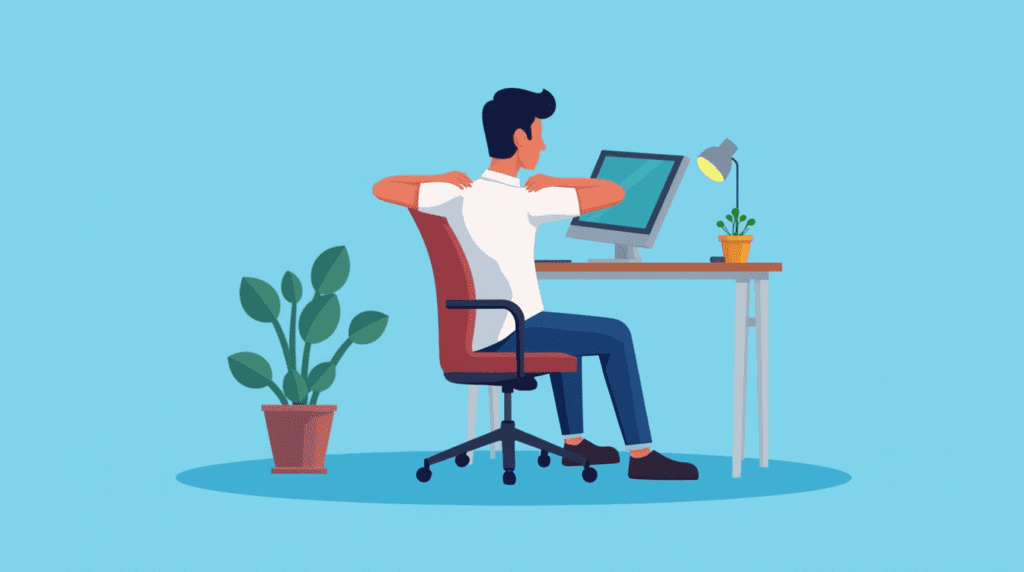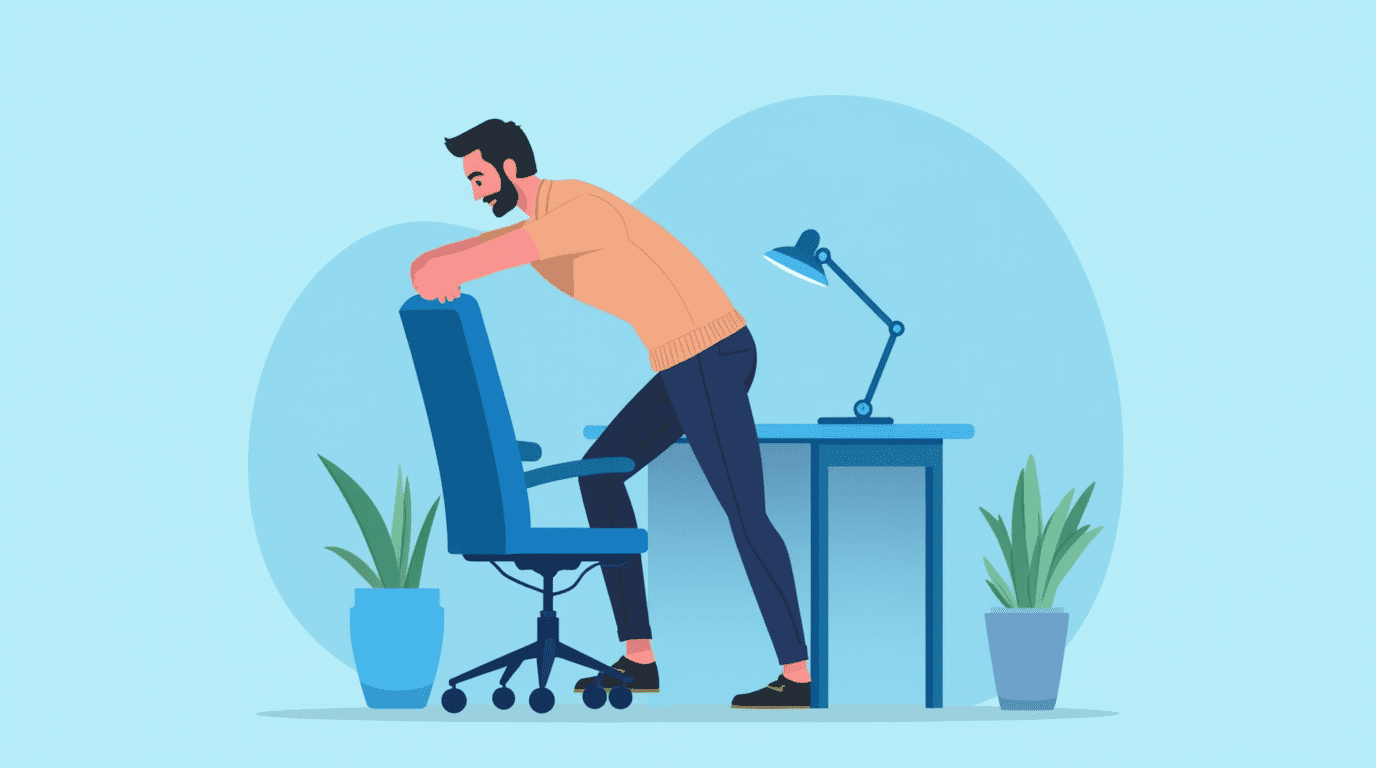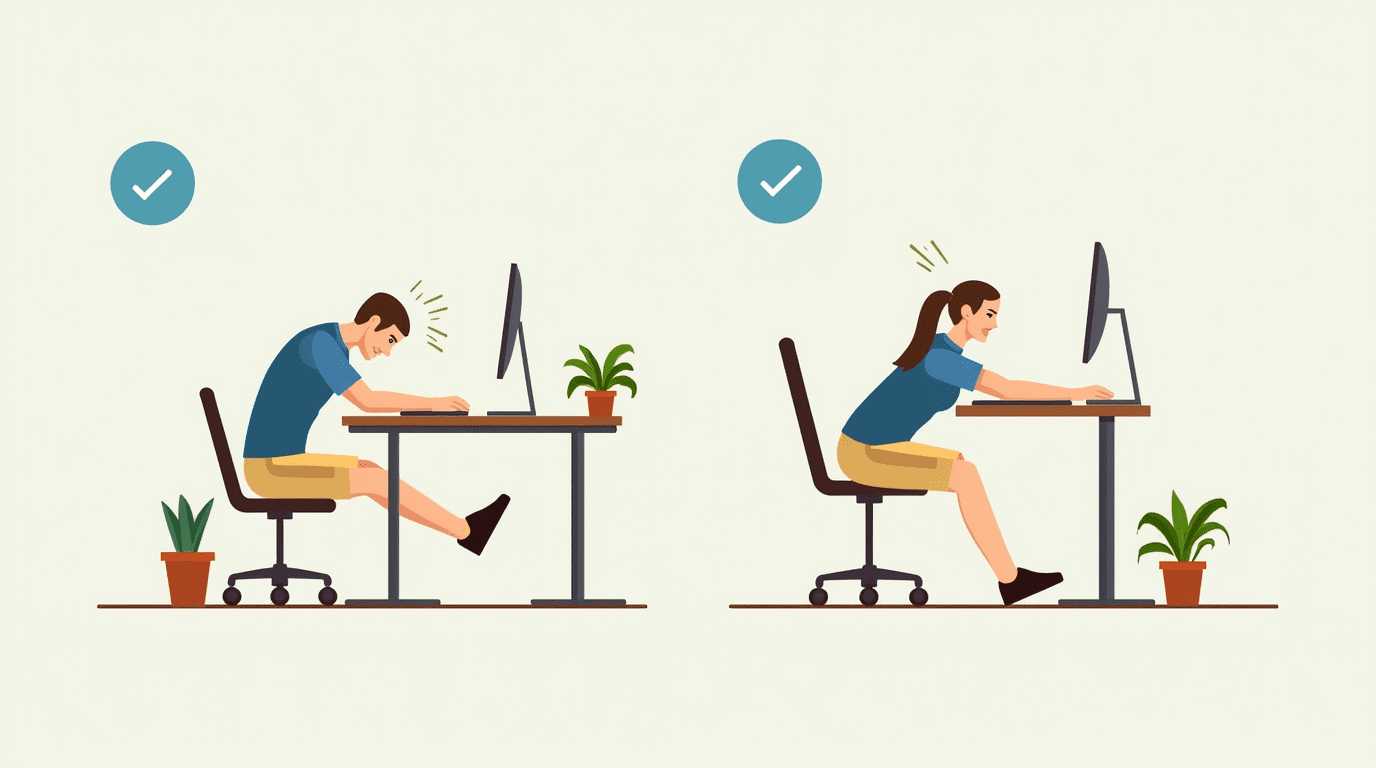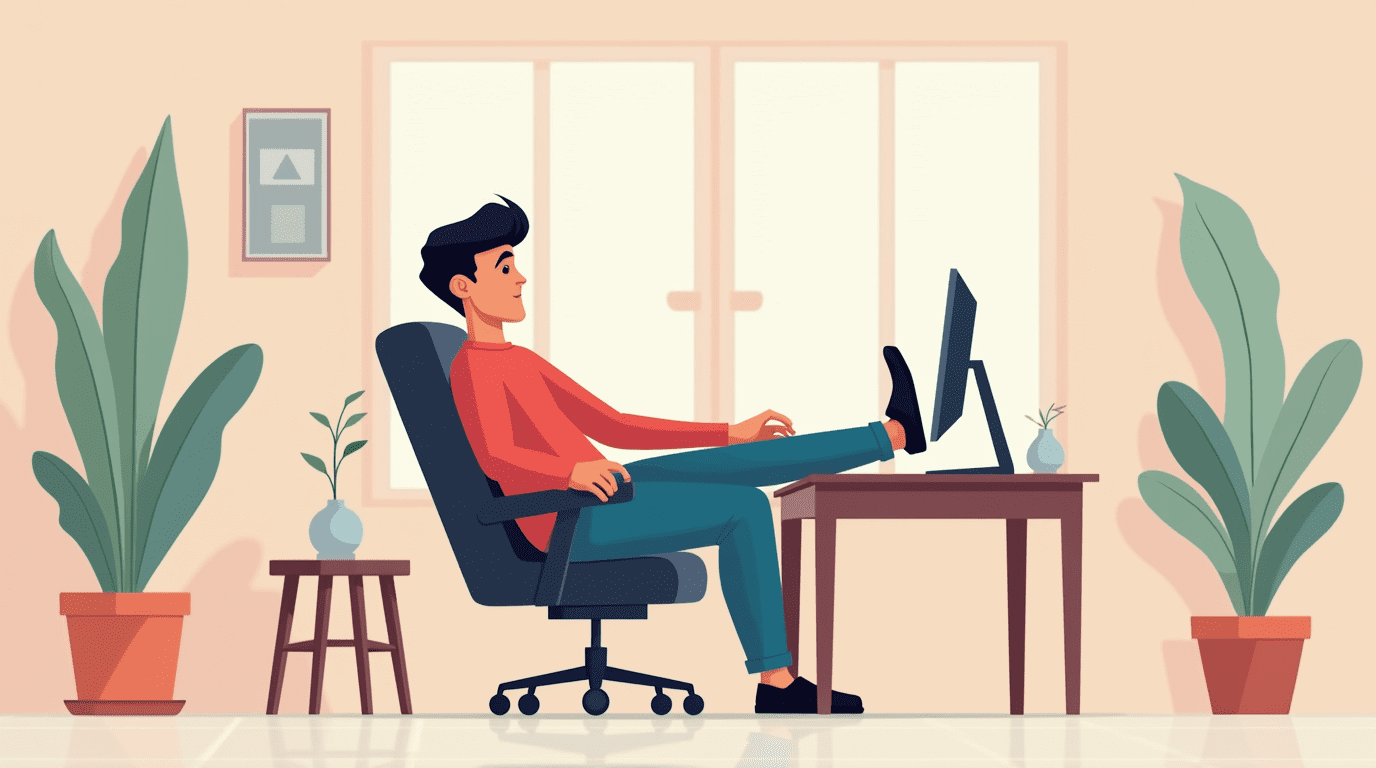Desk Stretches Overview
Stretching at the desk is essential for maintaining physical health and comfort throughout the workday. Desk stretches specifically designed for neck and shoulders can provide significant relief for desk workers.
Benefits of Desk Stretches
Desk stretches offer various benefits, particularly for those who spend long hours seated. Some key advantages include:
- Relief from Tightness: Stretches like shoulder shrugs and neck relaxers help to reduce muscle tightness in the neck and shoulders caused by prolonged sitting. Studies show that engaging in these stretches can alleviate discomfort associated with muscular tension (CCOHS).
- Improved Flexibility: Regular stretching increases flexibility and range of motion. Following proper techniques, such as holding stretches for 10-15 seconds, can effectively enhance flexibility without risk of injury (Environmental Health & Safety – UCSC).
- Enhanced Productivity: Taking stretch breaks can help refresh the mind, resulting in improved focus and concentration. Research indicates that brief rest periods can minimize discomfort without hindering productivity (Healthline).
- Reduced Risk of Injury: Engaging in desk stretches throughout the day may lower the risk of developing musculoskeletal injuries by promoting healthy movement and posture.
| Benefit | Description |
|---|---|
| Relief from Tightness | Reduces tension in the neck and shoulders |
| Improved Flexibility | Enhances range of motion |
| Enhanced Productivity | Boosts focus and concentration |
| Reduced Risk of Injury | Promotes healthy movement |
Importance of Stretching
The necessity of stretching stems from the physical demands placed on the body during work. Prolonged sitting can lead to discomfort and musculoskeletal pain:
- Muscle Tension and Pain: Sitting for extended periods can cause strains and discomfort in neck and shoulder regions. Desk stretches combat these effects through regular movement, helping to relieve pain and tightness.
- Counteracting Sedentary Behavior: An analysis found that at least 8 in 10 American workers are “desk potatoes,” leading to adverse effects on physical health. Counteracting this by incorporating stretches into the daily routine is essential (Healthline).
- Effective Breaks: While research on workplace stretching is still developing, the benefits of taking rest breaks have been shown to alleviate discomfort. Encouraging movement through stretching can enhance both wellbeing and workplace satisfaction (Environmental Health & Safety – UCSC).
Incorporating easy desk stretches, quick desk stretches, and seated desk stretches into the daily routine can make a substantial difference in alleviating tension and boosting overall health for desk workers.
Neck Stretches at Your Desk

Incorporating stretches into the workday can significantly alleviate tension and discomfort in the neck area. Here are three effective neck stretches that desk workers can do right at their desks: the Shoulder Shrug, Head Glide, and Neck Relaxer exercises.
Shoulder Shrug Exercise
The Shoulder Shrug is a simple yet effective way to relieve early symptoms of tightness or tension in the shoulders.
Instructions:
- Sit or stand comfortably with your arms at your sides.
- Slowly raise your shoulders toward your ears while inhaling.
- Hold for a few seconds.
- Exhale as you relax your shoulders back to their resting position.
- Repeat this exercise 5 to 10 times.
Head Glide Exercise
The Head Glide is designed to stretch the chest, neck, and shoulder muscles, providing relief from stiffness.
Instructions:
- Sit up straight with your shoulders relaxed.
- Gently tuck your chin toward your chest while keeping your head level.
- Glide your head backward, as though you are trying to make a double chin.
- Hold this position for a few seconds and then return to the starting position.
- Repeat 5 to 10 times.
This exercise not only stretches the muscles in the neck but also encourages proper neck alignment, which can improve overall posture.
Neck Relaxer Exercise
The Neck Relaxer focuses on relaxation of the neck muscles, reducing tension accumulated during prolonged periods of sitting.
Instructions:
- Sit in a comfortable position with your back straight.
- Tilt your head to one side, trying to bring your ear toward your shoulder.
- Hold the stretch for 15 to 30 seconds.
- Repeat on the other side.
- For added stretch, gently pull your head with your hand during the tilt.
This exercise should be done 3 to 4 times on each side to maximize its effectiveness.
Performing these desk stretches for neck and shoulders throughout the workday can help maintain comfort and prevent discomfort associated with sitting for extended periods. Additionally, incorporating other easy desk stretches throughout the day and ensuring an ergonomic workspace setup will further enhance neck and shoulder health.
Shoulder Stretches for Desk Workers
Incorporating stretches into the daily routine is essential for desk workers to alleviate tension and tightness in the shoulders. Two effective exercises to consider are the Shoulder Roll and Shoulder Relaxation Techniques.
Shoulder Roll Exercise
The Shoulder Roll exercise is designed to relieve stiffness in the shoulder muscles. It is straightforward and can be performed at the desk.
- Sit or stand up straight with arms at your sides.
- Slowly lift your shoulders toward your ears.
- Roll your shoulders back and down in a circular motion.
- Repeat the motion 10 times, then switch directions (forward).
| Direction | Repetitions |
|---|---|
| Backward | 10 |
| Forward | 10 |
This exercise aids in loosening tight shoulder muscles and can be particularly beneficial for those experiencing early symptoms of discomfort or tension in the neck and shoulders.
Shoulder Relaxation Techniques
Relaxation techniques can significantly help in mitigating shoulder pain, especially when stress levels are high. One effective method involves the following steps:
- Sit comfortably with your back straight.
- Take a deep breath and raise your shoulders towards your ears, holding them for a few seconds.
- Exhale while releasing your shoulders back down.
- Repeat this process for five breaths, focusing on relaxing the muscles each time you lower your shoulders.
Another method for shoulder relaxation includes squeezing and releasing the shoulder muscles with the opposite hand by gently applying pressure. This technique encourages blood flow and reduces tension in the shoulder region (Ergolink).
Regularly incorporating these stretches, along with other desk stretches for neck and shoulders, not only enhances comfort levels but also supports overall productivity while working at a desk.
Preventing Neck and Shoulder Pain
Preventing discomfort in the neck and shoulders is crucial for desk workers. Implementing ergonomic practices and incorporating movement breaks can significantly enhance well-being and productivity.
Ergonomic Workspace Setup
An ergonomic workspace setup is vital for minimizing neck and shoulder pain. This involves adjusting the desk, chair, and computer to promote a neutral posture. Key considerations for an ergonomic setup include:
| Component | Recommendations |
|---|---|
| Chair | Adjustable height with lumbar support |
| Desk | At elbow height when seated |
| Monitor | Eye level to prevent forward tilting of the neck |
| Keyboard and Mouse | Close enough to avoid reaching |
Research indicates that making adjustments to workplace environments can lessen discomfort associated with prolonged sitting. Organizations should consider investing in ergonomic furniture and tools. Tools like reminder apps, such as StretchClock, can encourage regular stretching and movement.
Importance of Movement Breaks
Incorporating movement breaks throughout the workday is essential. Prolonged sitting can lead to muscular tension and pain, making it important to take breaks for stretches. A five to ten-minute break to perform stretches can alleviate discomfort and improve overall mental and physical well-being Environmental Health & Safety – UCSC.
Research has shown that regular rest breaks can reduce discomfort without negatively impacting productivity in the workplace Healthline. Furthermore, engaging in brief physical activity during the day helps relieve both physical and mental stress, positively affecting overall health Healthline.
To effectively implement movement breaks, desk workers should schedule reminders to stand, stretch, or walk around periodically. Adopting a routine that includes both desk stretches for neck and shoulders and other activities can help maintain comfort. Consider integrating both quick desk stretches and seated desk stretches into the daily schedule for best results.
Research on Desk Stretches
Understanding the impact of desk stretches is important, especially for desk workers who may experience strain from prolonged sitting. Research has shown that implementing stretching programs can be beneficial in several key areas.
Effectiveness of Workplace Stretching Programs
Stretching programs in workplaces have been found to improve range of motion, posture, and provide stress relief. Regular participation in these programs leads to noticeable benefits in daily comfort and effectiveness during work hours.
A review of several studies reports that periodic workplace stretching may reduce pain by up to 72 percent. This demonstrates that implementing structured stretching routines is a valuable strategy for desk workers. The table below summarizes the benefits and reported outcomes of workplace stretching programs.
| Benefit | Outcome |
|---|---|
| Improved Range of Motion | Increased flexibility |
| Enhanced Posture | Better sitting alignment |
| Stress Relief | Lowered mental and physical stress |
| Pain Reduction | Up to 72% decrease in discomfort |
| Productivity | No significant negative impact |
Research indicates that periodic workplace stretching does not significantly affect productivity, allowing workers to integrate these practices without fear of reduced efficiency. More about the benefits of stretching can be found in our guide on easy desk stretches.
Studies on Desk Workers’ Musculoskeletal Health
The rising trend of sedentary jobs has garnered attention regarding the health of desk workers. An analysis revealed that at least 8 in 10 American workers are often referred to as “desk potatoes,” which can lead to various health issues, particularly musculoskeletal discomfort (Healthline).
Research suggests that a bit of exercise during the workday can relieve both physical and mental stress for desk workers. Specifically, studies have shown a correlation between regular stretching and reduced discomfort in the neck and shoulders, common areas affected by long hours at a desk.
For those looking for quick relief, simple quick desk stretches can be easily incorporated into a workday. Regular stretching throughout the day is crucial for maintaining musculoskeletal health and overall well-being.
Enhancing Workstation Comfort
Creating a comfortable workstation is essential for desk workers to minimize discomfort and prevent injuries. This can be achieved through a combination of in-chair stretches and the use of ergonomic equipment.
In-Chair Stretches
In-chair stretches are simple and effective movements that desk workers can perform to alleviate tension in the neck and shoulders. Regular practice of these stretches can improve comfort levels and decrease the risk of musculoskeletal injuries. Here are some recommended in-chair stretches:
| Stretch | Description | Duration |
|---|---|---|
| Neck Side Stretch | Sit upright and gently tilt your head to one side, bringing your ear toward your shoulder. Hold and repeat on the other side. | 15-30 seconds per side |
| Shoulder Shrug | Raise both shoulders towards your ears, hold for a moment, then release. Repeat multiple times. | 10-15 reps |
| Seated Torso Twist | Sit upright and gently twist your torso to one side, using your hand to hold onto the chair for support. Repeat on the other side. | 15-30 seconds per side |
Regular in-chair stretches, combined with periodic movement throughout the day, can enhance productivity and reduce discomfort (Ergolink).
Ergonomic Equipment Recommendations
Using ergonomic equipment is crucial for creating an efficient workstation. This type of equipment allows for a more natural posture, reducing strain on the neck and shoulders caused by typing and mouse movements. Here are some key ergonomic tools to consider:
| Equipment | Benefit |
|---|---|
| Ergonomic Mouse | Helps maintain a natural wrist position and reduces strain associated with mouse movements. |
| Ergonomic Chair | Provides support for the lower back, encouraging good posture and reducing pressure on the neck and shoulders. |
| Sit-Stand Desk | Allows users to alternate between sitting and standing, promoting movement and reducing the risk of long-term static positions. |
Switching to ergonomic office equipment not only improves comfort but can also prevent injuries that arise from repetitive motions (Ergolink). By adopting these ergonomic solutions and incorporating regular easy desk stretches, desk workers can significantly enhance their workstation comfort and overall well-being. For additional information on specific stretches, explore our guide on quick desk stretches and seated desk stretches for effective practices throughout the workday.



